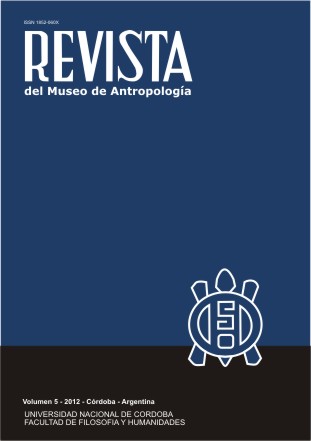Implementation of spectrochemical techniques in zooarchaeological research. Strontium quantification using Laser Induced Breakdown Spectroscopy (LIBS)
DOI:
https://doi.org/10.31048/1852.4826.v5.n1.9196Keywords:
chemical spectrum techniques, replacement of bone matrix, standard addition, laser induced breakdown spectroscopy (LIBS)Abstract
Chemical studies on zooarchaeological remains have been most extensively developed in recent decades, especially those focused on the identification of chemical fingerprints or types of isotopes and their relationships. This paper aims at showing two procedures used for chemical characterization of bones on the basis of spectrometric data obtained by LIBS technique (Laser Induced Breakdown Spectroscopy). One called Standard Addition, a destructive procedure, with a high error degree; the other called Bone Matrix Replacement, a noninvasive method with a relatively low error degree. We expect to gather a methodological and analytical corpus to characterize, efficiently and inexpensively, the chemical fingerprints of diverse archaeofaunal material. Hence, we intend to achieve chemical characterization of archaeological bones in order to address issues related to animal eating habits and mobility in the past.Downloads
References
Bowen, G.J.; West, J.B.; Vaughn, B.H.; Dawson, T.E.; Ehleringer, J.R.; Fogel, M.L.; Hobson, K.A.; Hoogewerff, J.; Kendall, C.; Lai, C.T.; Miller, C.C.; Noone, D.; Schwarcz, H.P. y Still, C.J. 2009. Isoscapes to address large-scale Earth science challenges. Eos 90: 109-116.
Burton, J.H.; T.Price y W. D. Middelton. 1999. Correlation of bone Ba/Ca and Sr/Ca due to biological purification of calcium. Journal of Archaeological Science 26:609-16
Burton, J., T. Price, L. Cahuee y L. Wright. 2003. The use of barium and strontium abundances in human skeletal tissues to determine their geographic origins. International Journal of Osteoarchaeology 13:88-95.
Capello, C. 2009. Desarrollo y puesta a punto de técnicas espectroquímicas: Cuantificación de Sr en hueso mediante LIBS. Practicanato profesional de la Licenciatura en Química. Facultad de Ciencias Químicas, UNC.
Capello M. C.; I. Cabanillas-Vidosa; A. Izeta; J. C. Ferrero y G. A. Pino. 2009. Cuantificación de Sr en muestras óseas arqueológicas por medio de Ablación Láser Pulsada acoplada a Espectroscopia de Emisión Óptica (LAP-OES). Trabajo presentado en el XVI Congreso Argentino de Fisicoquímica y Química Inorgánica. Salta, 18 al 21 de mayo de 2009.
De Niro, M.J. 1985. Postmortem preservation and alteration of in vivo bone collagen isotope ratios in relation to paleodietary reconstruction. Nature 317: 806-809.
Figueroa, G. G.; M.Dantas y A. Laguens. 2010. Practicas agropastoriles e innovaciones en la producción de plantas y animales en los Andes del Sur. El Valle de Ambato, Argentina, primer milenio d.C. International Journal of South American Archaeology 7: 6-13.
Finucane, B. 2004. Isotopes and animal management at Conchopata, Perú. Unpublished Master Dissertation. School of Archaeology, Oxford University. URL: www.rlaha.ox.ac.uk/people/BF2-1.pdf
Finucane, B., P. Maita Agurto y W. H. Isbell. 2006. Human and animal diet at Conchopata, Peru: stable isotope evidence for maize agriculture and animal management practices during the Middle Horizon, Journal of Archaeological Science 33: 1766-1776
Gross, J.H. 2004. Mass Spectrometry. A textbook. Springer. 518 pp
Izeta, A. D. 2007. Zooarqueología del sur de los valles Calchaquíes (Provincias de Catamarca y Tucumán, República Argentina): Análisis de conjuntos faunísticos del primer milenio A.D. B.A.R. International Series S1612. John and Erica Hedges, Oxford, Inglaterra
Izeta, A. D., A. G. Laguens, B. Marconetto y M. C. Scattolin. 2009. Camelid use in Meridional Andes during first millennium A.D. A preliminary approach using stable isotopes. International Journal of Osteoarchaeology 19: 204-214.
Izeta, A. D., M. Dantas, M. G. Srur, M. B.Marconetto y A. G. Laguens. 2010. Isótopos estables y manejo alimentario de camélidos durante el primer milenio A.D. en el valle de Ambato (noroeste argentino). En Bertolino, S, Cattaneo G. R y A. D. Izeta (Eds) La arqueometría en Argentina y Latinoamérica. Editorial de la FFyH, Córdoba.
Ortega R. R. 2006. Fundamentos teóricos y técnicos de los isótopos estables. En: http://www.ruena.csic.es/pdf/ponencia_ruena_2006_redondo.pdf.
Panarello, O.H. y J. Fernández. 2002. Stable isotope carbon isotope measurements on hair from wild animals from altiplanic environments of Jujuy. Radiocarbon 44: 709-716.
Szostek, K.; H. Glab y A. Pudlo. 2009. The use of strontium and barium analyses for the reconstruction of the diet of the early medieval coastal population of Gdansk (Poland): A preliminary study. HOMO-Journal of Comparative Human Biology 60: 359–372.
Wada, E., T. Yoneyama, M. Minagawa, T. Ando, and B.D. Fry (eds.), 1995. Stable Isotopes in the Biosphere. Kyoto University Press, Japan.
Wing, E. S. y A. B. Brown. 1979. Paleonutrition. Method and theory in prehistoric foodways. Academic Press. New York.
Downloads
Published
Issue
Section
License
Those authors who have publications with this Journalaccept the following terms:
a. Authors will retain their copyrights and guarantee the journal the right of first publication of their work, which will be simultaneously subject to the Creative Commons Attribution License (Licencia de reconocimiento de Creative Commons) that allows third parties to share the work as long as its author and his first publication in this journal.
b. Authors may adopt other non-exclusive licensing agreements for the distribution of the version of the published work (eg, deposit it in an institutional electronic file or publish it in a monographic volume) provided that the initial publication in this journal is indicated.
c. Authors are allowed and recommended to disseminate their work on the Internet (eg in institutional telematic archives or on their website) before and during the submission process, which can lead to interesting exchanges and increase citations of the published work. (See The Effect of Open Access - El efecto del acceso abierto)












